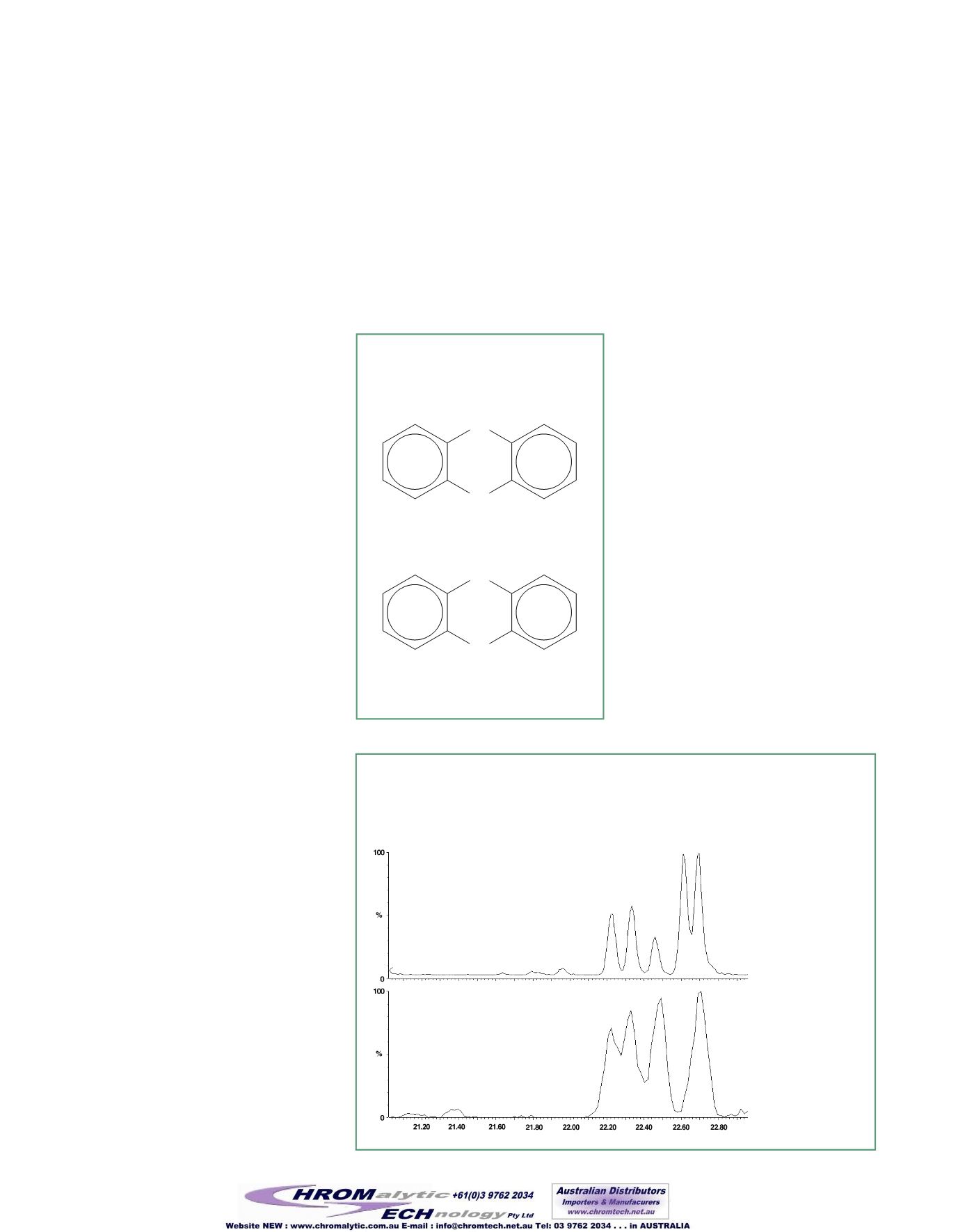

1234
• 6 •
www.restekcorp.comRESTEK Advantage
800-356-1688
Improved Resolution of Dioxins
and Furans by GC-High-
Resolution Mass Spectrometry,
Using an Rtx
®
-Dioxin Capillary Column
By Frank L. Dorman, Ph.D., Director of Technical Development
✔
Improved separation of dioxin and furan congeners, compared to 5% diphenyl columns.
✔
Greater thermal stability than 5% diphenyl columns or high-cyano confirmation columns.
✔
May eliminate confirmation analysis.
Figure 1 —
Chlorine substitution in the basic
dioxin structure creates 136 congeners.
Temperature program:
Time Rate
Temp.
(min.) (ºC/min.) (ºC)
0
52
200
10.2 2.9
235
10
6.9
300
24
Injector temp.: 270ºC
Flow: 1.2mL/min. (constant pressure)
Gas chromatographic analysis coupled to high-reso-
lution mass spectrometry is a common method of
evaluating environmental samples for dioxins and
furans. Dioxins and furans are monitored due to the
toxicity of congeners that have chlorine substitution
at positions 2, 3, 7, and/or 8 (Figure 1). In the US,
the most common analysis methods for these com-
pounds are USEPA methods 1613 and 8290, but the
analysis is performed similarly in many countries.
The overall goal of the analysis is to accurately quan-
tify the 17 toxic dioxin and furan congeners by sepa-
rating them from 119 other congeners.
In order to achieve the desired separation, most
methods describe an initial analysis on a 5%
diphenyl/95% dimethyl polysiloxane stationary
phase. If 2-, 3-, 7-, and/or 8-substituted congeners
are detected in this analysis, most methods require a
confirmatory analysis on a stationary phase that sep-
arates these congeners from the less toxic con-
geners. While no single column has been universally
agreed upon as the best confirmation column, most
analysts use a high-cyano stationary phase. While
these columns offer better separation of the 2-, 3-,
7-, 8-substituted congeners, analysts using any of
them must contend with poor thermal stability (max-
imum operating temperatures of approximately
250ºC) and poor column lifetimes, compared to 5%
diphenyl-type columns used for the primary analysis.
The difficulty with using the results from 5%
diphenyl columns is that there are several known
coelutions of environmentally-occurring 2-, 3-, 7-, 8-
substituted congeners with less toxic congeners. This
leads to falsely high values for the toxic congeners
on the 5% diphenyl column, and to unnecessary
confirmatory analysis.
An ideal stationary phase for this application would
combine excellent separation, high thermal stability
and, thereby, long column lifetime. With these goals
in mind, Restek has developed the Rtx
®
-Dioxin col-
umn. The new, proprietary stationary phase, specifi-
cally developed for dioxins/furans analysis, is stable
to temperatures above 425ºC. When coated onto
high-temperature fused silica tubing, the thermal
limit of the column is a function of the polyimide
outer coating: 380ºC. Not only is this is a major
improvement over the thermal stability of high-cyano
phases, it is an improvement over the capabilities of
5% diphenyl phases as well.
An Rtx
®
-Dioxin column better separates the dioxin
and furan congeners, compared to 5% diphenyl
columns. Most analysts experienced with dioxin and
furan separations are familiar with the 4-peak tetra-
chlorodibenzodioxin mass pattern from a 5%
diphenyl column, as shown in Figure 2A. An Rtx
®
-
Dioxin column separates all five components in the
resolution check mixture for this mass window—a
significant improvement (Figure 2B). Note that
1,2,3,7- TCDD and 1,2,3,8-TCDD are tentatively
identified; reference materials for individual con-
geners are not available.
Because few of the individual dioxin and furan con-
geners are available as reference materials, analysis
of fly ash extracts is the accepted test of whether a
column resolves the toxic congeners from the non-
toxic congeners. In analyses of three fly ash extracts
used in a recent international round-robin study,
data from an Rtx
®
-Dioxin column agreed to within
±10% of the “true” values for all 2-, 3-, 7-, 8-substi-
tuted congeners, except for one penta- and one
hexa-furan. This also is a significant improvement
over 5% diphenyl column performance for the pri-
mary analysis. Table 1 (page 7) summarizes data for
2,3,7,8-tetrachlorodibenzofuran from an Rtx
®
-
Dioxin column, a 5% diphenyl column, and a high-
cyano column, compared to median and mean from
an international round-robin study. Excellent agree-
ment between the median and the mean, and
between the Rtx
®
-Dioxin column and the study data,
gives confidence in the proximity to the “true” value.
Further work toward optimizing flow and oven tem-
perature is in progress, to determine if the Rtx
®
-
Dioxin column could eliminate the need for high-
cyano phases for confirmation.
In summary, the new Rtx
®
-Dioxin column is a signif-
icant improvement over 5% diphenyl columns com-
monly used in the primary analysis for dioxins and
Figure 2 —
Rtx
®
-Dioxin column separates all five components in the resolution check mixture.
Chromatography courtesy of Karen MacPherson and Eric Reiner, Ontario Ministry of the Environment, Etobicoke, ON, Canada.
Conditions
Instrument: Micromass Altima high resolution GC/MS
Column: Rtx
®
-Dioxin, 40m, 0.18mm ID, 0.10µm (cat.# 10756)
Initial temp.: 130ºC
Cl
Cl
Cl
Cl
O
O 1
2
3
4
6
7
8
9
O
O
General structure for dioxin congeners
3Å by 8Å molecule fits PAH receptors,
makes 2,3,7,8-tetrachlorodibenzodioxin
especially toxic
Continued on page 7
1237
2378 1239
1238
1234
1237, 1238
2378
1239
2A) Rtx-5
®
Column
2B) Rtx-5
®
Dioxin Column
TCDD-resolution mixture


















